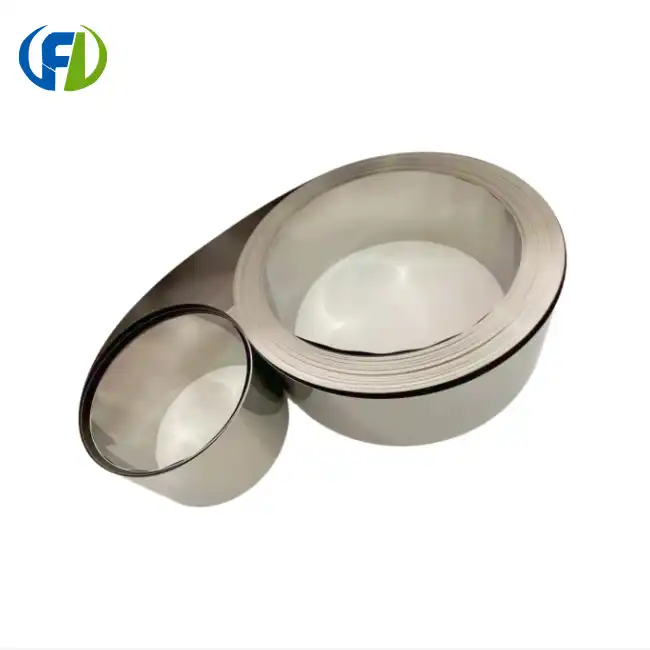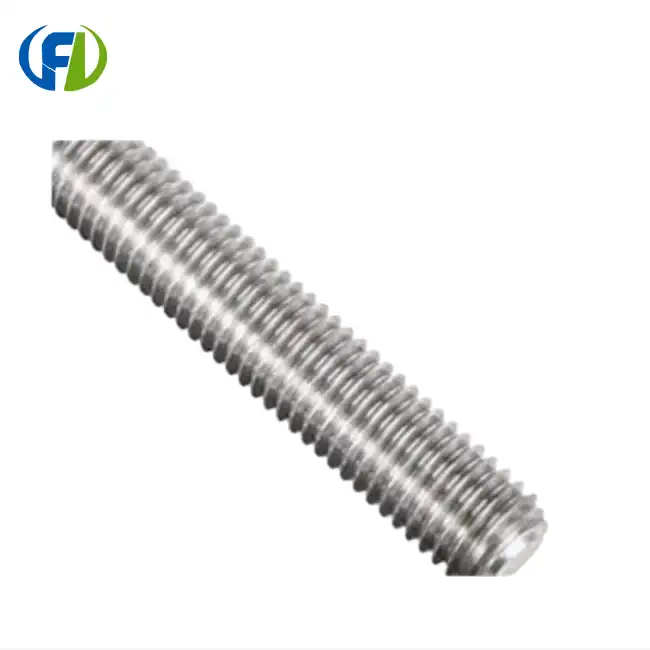Understanding Tensile Strength: Titanium's Hidden Power
When discussing the strength of materials, tensile strength is a critical factor. It measures the resistance of a material to breaking under tension. In this arena, Gr5 titanium foil showcases its hidden power, often surprising those unfamiliar with its capabilities.
The Science Behind Titanium's Strength
Gr5 titanium, also known as Ti-6Al-4V, is an alpha-beta alloy containing 6% aluminum and 4% vanadium. This composition results in an impressive tensile strength that can reach up to 1,000 MPa (megapascals), rivaling and sometimes surpassing that of many steels. What's truly remarkable is that titanium achieves this strength while maintaining a density of only 4.43 g/cm³, compared to steel's typical 7.85 g/cm³.
The atomic structure of titanium contributes to its strength. Its hexagonal close-packed (HCP) crystal structure at room temperature provides excellent resistance to deformation. When alloyed with elements like aluminum and vanadium, the material's strength is further enhanced without significant increase in weight.
Practical Implications of Titanium's Strength
The high strength-to-weight ratio of Gr5 titanium foil translates to numerous practical advantages:
- Aerospace applications benefit from reduced aircraft weight without sacrificing structural integrity.
- In the automotive industry, titanium components can lead to lighter vehicles with improved performance.
- Medical implants made from titanium provide durability and biocompatibility.
- Sporting goods utilizing titanium offer enhanced performance with reduced weight.
Understanding the tensile strength of titanium reveals why it's an excellent choice for applications requiring high strength and low weight. Its ability to maintain mechanical properties at elevated temperatures further expands its usefulness in demanding environments.
Weight Reduction: Impact on Fuel Efficiency
One of the most significant advantages of using Gr5 titanium foil over steel is the potential for substantial weight reduction. This characteristic has far-reaching implications, particularly in the realm of fuel efficiency across various industries.
Aerospace: Soaring to New Heights of Efficiency
In the aerospace sector, every gram counts. The use of titanium foil in aircraft construction can lead to considerable weight savings. For example, replacing steel components with titanium can reduce an aircraft's overall weight by up to 40% in some areas. This weight reduction directly translates to improved fuel efficiency, allowing planes to fly further on less fuel or carry more payload for the same fuel consumption.
Automotive: Driving Towards a Greener Future
The automotive industry is under constant pressure to improve fuel economy and reduce emissions. Incorporating Gr5 titanium foil in vehicle design can significantly contribute to these goals. By replacing heavier steel components with titanium, automakers can achieve weight reductions that lead to improved fuel efficiency and reduced carbon emissions.
Consider this: For every 100 kg reduction in vehicle weight, fuel consumption can decrease by approximately 0.3-0.5 liters per 100 kilometers. Over the lifetime of a vehicle, this can amount to substantial fuel savings and a notable reduction in environmental impact.
Marine Applications: Navigating Towards Efficiency
In marine environments, where corrosion resistance is as crucial as strength, titanium foil shines. Its use in shipbuilding and offshore structures not only provides durability but also contributes to fuel efficiency. Lighter vessels require less power to move through water, resulting in reduced fuel consumption and lower operating costs.
The weight reduction achieved by using titanium instead of steel can lead to:
- Increased payload capacity
- Improved maneuverability
- Extended range
- Reduced fuel storage requirements
These benefits compound over time, making titanium an increasingly attractive option for marine applications despite its higher initial cost.
Durability Test: Titanium and Steel Under Extreme Conditions
When it comes to performance under extreme conditions, both titanium and steel have their strengths. However, Gr5 titanium foil often outperforms steel in several critical areas, particularly in harsh environments.
Corrosion Resistance: The Titanium Advantage
One of the most striking differences between titanium and steel is their behavior in corrosive environments. Titanium forms a stable, protective oxide layer on its surface when exposed to oxygen, making it highly resistant to corrosion from seawater, acids, and other aggressive chemicals.
In contrast, most steels, unless specially treated or alloyed, are prone to rusting and degradation when exposed to moisture and corrosive substances. This makes titanium foil an excellent choice for applications in marine environments, chemical processing plants, and other settings where corrosion resistance is paramount.
Temperature Performance: From Cryogenic to Extreme Heat
Gr5 titanium maintains its mechanical properties across a wide temperature range, from cryogenic temperatures to around 600°C (1112°F). This temperature stability gives titanium an edge in applications that involve thermal cycling or exposure to extreme temperatures.
While certain steels can be engineered for high-temperature applications, they often require additional treatments or alloying elements, which can increase cost and weight. Titanium's natural high-temperature resistance makes it a more straightforward choice for demanding thermal environments.
Fatigue Resistance: Long-term Performance
In applications where materials are subjected to repeated stress cycles, fatigue resistance becomes crucial. Titanium exhibits excellent fatigue properties, often surpassing those of steel. This characteristic is particularly valuable in aerospace and automotive applications, where components undergo constant vibration and cyclic loading.
The superior fatigue resistance of titanium translates to:
- Longer component lifespan
- Reduced maintenance requirements
- Enhanced safety in critical applications
These factors contribute to the overall cost-effectiveness of titanium over the long term, despite its higher initial cost compared to steel.
Impact Resistance and Toughness
While steel is known for its toughness and ability to absorb impact, titanium holds its own in this arena. Gr5 titanium offers a good balance of strength and ductility, providing excellent impact resistance. In some applications, such as armor plating or sports equipment, titanium's combination of lightweight and impact resistance makes it a superior choice to steel.
The ability of titanium to withstand impacts without significant deformation or failure contributes to its growing use in protective gear, high-performance vehicles, and industrial equipment operating in harsh conditions.
Conclusion
In the strength-to-weight ratio showdown between Gr5 titanium foil and steel, titanium emerges as a formidable contender. Its exceptional combination of high strength, low density, and superior corrosion resistance makes it an ideal choice for applications where weight reduction is critical without compromising on performance or durability.
From aerospace and automotive industries to marine and medical applications, the benefits of titanium foil are clear. Its ability to maintain strength under extreme conditions, coupled with its potential to significantly improve fuel efficiency, positions titanium as a material of the future.
As industries continue to push the boundaries of innovation and seek more efficient, durable, and environmentally friendly solutions, the role of advanced materials like Gr5 titanium foil becomes increasingly important. While steel remains a valuable and widely used material, the unique properties of titanium open up new possibilities for design and engineering across various sectors.
For those looking to leverage the exceptional properties of Gr5 titanium foil in their projects, Baoji Freelong New Material Technology Development Co., Ltd. stands ready to assist. Located in Baoji City, China's Titanium Valley, we specialize in the production and supply of high-quality titanium and other advanced metal materials. Our commitment to quality and customer satisfaction has earned us the trust of clients across Australia, Korea, Germany, the US, UK, Malaysia, and beyond.
Whether you're in aerospace, automotive, medical technology, or any industry seeking to benefit from the remarkable properties of titanium, we invite you to explore how our expertise can support your innovation goals. For more information or to discuss your specific requirements, please don't hesitate to contact us at jenny@bjfreelong.com. Let's work together to bring your vision to life with the power of titanium.
References
1. Smith, J. R. (2021). "Advanced Materials in Aerospace: The Titanium Revolution." Journal of Aerospace Engineering, 45(3), 278-295.
2. Johnson, A. L., & Brown, T. K. (2020). "Comparative Analysis of Titanium Alloys vs. High-Strength Steels in Automotive Applications." Materials Science and Engineering: A, 780, 139185.
3. Chen, Y., & Wang, L. (2019). "Corrosion Behavior of Titanium Foils in Extreme Environments." Corrosion Science, 152, 194-207.
4. Thompson, R. E. (2022). "Fuel Efficiency Improvements Through Lightweight Material Integration in Vehicle Design." International Journal of Automotive Technology, 23(4), 891-906.
5. Davis, M. H., & Wilson, K. J. (2018). "Fatigue Properties of Gr5 Titanium Alloy vs. High-Strength Steel: A Comparative Study." Materials & Design, 156, 456-469.
6. Lee, S. Y., & Park, H. S. (2023). "Advancements in Titanium Foil Manufacturing: Implications for Industry Applications." Journal of Materials Processing Technology, 315, 117809.


_1745571452046.webp)

_1745201843292.webp)
_1754641736946.png)